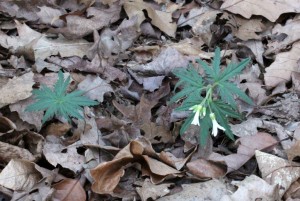In the earliest days of Spring we have only a few splotches of color starting the blooming eruption.
Flowers of the spring bulbs and garden plants that we planted are much more visible than the native flowers that are blooming this early. The native ones tend to grow low so they’re not quite as able to be seen as the happy daffodils.
Forsythia blossoms are pushing open. They’re not fully open yet, but yesterday you could start to see the bright yellow. Today more yellow is visible.

Crocuses have come and gone — into the belly of some critter — and the daffodils are shouting in all their happy orange and yellow that Spring is here! They look great in the sunshine, don’t they?
Tulip greenery is up and the Star Magnolia blossoms should open up any day now as they are getting pretty big. You can see the petals getting longer as they grow and soon they’ll finally push their buds to bursting.
One plant that might be found blooming much earlier, even before Skunk Cabbage according to a fellow garden enthusiast from New York State, is known as a hellebore, which is native to the Far East so we had to plant it here in Pennsylvania. Hellebores can take the cold and may even be found blooming in the middle of winter.
As far as native plants go,
the cut-leaved toothwort that was planted on the east side of the house has two blooms open now. The first one opened up a couple of days ago. More blooms will follow as their buds are now visible. And, there’s a whole new plant this year! (Photo taken 26Mar2016.)

Of course, the Pennsylvania Bittercress has been blooming now for a couple of weeks. And it will grow anywhere it can find a little sunshine. Its rosettes hide in the grass one year and overwinter. Then, in very late Winter a flowering stalk is sent up to be the earliest bloomer we have. Native, that is.
When the red flowers of maple trees are popping out the time of year is right to look for other flowering plants. Very early Spring, say late March to early April, kicks off the blooming season.
As you go driving down the road and pass by an open field, look for a purple haze. We have purple dead nettle growing in great amounts in soybean and corn fields. Nearby, you’ll likely find chickweed blooming or maybe a speedwell.
That’s five different natural flowers in the first two weeks of Spring.
So, why do these earliest flowering plants grow so low?
Low-growing “weeds” do seem to get going early in the year. It’s warmer nearer the ground so they will be able to grow faster than their taller cohorts.
They get to avoid a lot of the wind that occurs in Spring. Wind can be very drying, so low-growing plants will have an advantage here. See for yourself how little wind is near the ground on a blustery day. When it’s sunny and pretty windy, lie down on the ground and feel the warmth of the earth. It should be obvious how being closer to the ground will provide some refuge from too much air movement.
Also, size does matter. As a small plant when you’re little you don’t have as much material to create before you can get to reproducing. So, chances are good that you’ll be ready to flower before your larger cousins are prepared to blossom.
When thinking about these plants, don’t forget that they’re in an entire ecosystem. Perhaps part of the reason they’re ready to bloom so early in the year is that their pollen and nectar will feed small insects which are part of a larger food web. Haven’t you heard the sounds of Spring from the song birds and Spring peppers?
So, even though you may think the pesky PA Bittercress is a weed in your lawn, just remember that it’s showing us the time is right to start looking for flowers to pop out elsewhere in the scenery. The cycle of life continues!